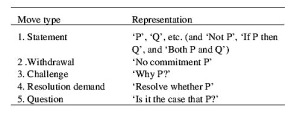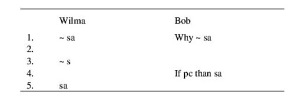ISSA Proceedings 1998 – Dialogical Argumentation: Statement-Based, Argument-Based And Mixed Models
No comments yet 1. Introduction
1. Introduction
The dialectical style of studying argumentation is old, very old. Already Aristotle and Protagoras did recognize the dialectical nature of argumentation. A few millennia later, from the beginning of the 1990s onwards to be exact, researchers involved in the field of Artificial Intelligence & Law (AI & Law) became interested in dialogical models of argumentation [e.g., Gordon, 1993; Loui et al., 1993; Farley & Freeman, 1995; Lodder & Herczog, 1995; Prakken, 1995; Kowalski & Toni, 1996]. By approaching argumentation dialogically the research on AI & Law followed in the footsteps of prominent researchers from various fields, like philosophy [e.g., Perelman & Olbrechts-Tyteca, 1971; Habermas, 1973; Rescher, 1977], logic [e.g., Lorenz, 1961; Barth & Krabbe, 1982], legal theory [e.g., Aarnio, Alexy & Peczenik et al., 1981], and argumentation [e.g., Hamblin, 1970; Van Eemeren & Grootendorst, 1982; Woods & Walton, 1982].
There is a difference between the product and process of argumentation. If the product of argumentation is studied, general structures of support between sets of premises and a conclusion are defined. In a product-approach of argumentation a statement is justified:
– if the premises are justified, and
– if by valid inference,
– the conclusion can be derived from the premises.
The product of argumentation is static. Conversely, the process of argumentation is dynamic. If the process of argumentation is studied procedural rules are defined that determine for each stage of the process whether a statement is justified. In a process approach of justification a statement is justified:
– if after a sequence of one or more steps, the statement is justified according to the rules of the procedure.
If the procedural model of argumentation is defined as a dialog game, statements are justified if they are successfully defended in a dialog, that is, if a player (the proponent of the statement) succeeded in convincing his opponent. A commonly accepted starting point in dialogical models is that a player who claims a sentence must be willing to defend it, or, in other words, on the claiming players rests the burden of proof. This paper elaborates on the various ways this defense can be modeled. Therefore, three dialogical models of argumentation are discussed. One, probably the best known dialogical model of argumentation, stems from the field of argumentation: MacKenzie’s DC. The other two are AI & Law models: Gordon’s Pleadings Game and my own DiaLaw. Especially by concentrating on the possible moves of the game and the way in which commitment is used, these models will be characterized. Moreover, by showing a representation of the same sample dialog in the three models differences are illustrated. The reason to discuss these three models is that they are examples of what I like to call statement-based models (DC), argument-based models
(Pleadings Game), and mixed models (DiaLaw). Besides introducing this taxonomy of models, the different model types are related to the possible purposes of argumentation models, viz. empirical purposes, theoretical purposes and normative purposes.
The paper is structured as follows. First, definitions are given of both arguments and statements. Subsequently, the legal sample dialog is introduced and the three models are discussed. Finally, the possible purposes of argumentation models are briefly introduced, and it is suggested that a statement-based model is best suited as an empirical model, that a mixed-model is best-suited as a theoretical model, and that an argument-based model is best suited as normative model.
2. Terminology
There is a difference between a statement and an argument. Suppose we have two statements:
1. Jeffrey is punishable, and;
2. Jeffrey has intentionally killed someone.
An argument shows a relation between statements. Arguments indicate that a statement supports or justifies another statement. An example is the argument that Jeffrey is punishable, because he has intentionally killed someone.
Since we are dealing with dialogical models, the discussion is restricted to statements and arguments that are putted forward in a dialog. If a concrete support relation is expressed, what is asserted is called an argument. If the support relation is general, e.g., a rule or principle, what is asserted is called a statement. In fact, if not a concrete support relation is expressed, what is asserted is called a statement. An argument indicates a support relation between sentences or propositions that could be expressed as statements.
Since everybody is familiar with the Modus Ponens argument, I will use this argument type to illustrate the difference between a statement and an argument. The premises A and A _ B together with the conclusion B can be used in the following Modus Ponens argument.
A
A -> B
_______
B
Note that the Modus Ponens argument in fact has three elements.
First, a set of premises: {A -> B, A}. Second, a conclusion: B.
Finally, a derivation rule (implicitly present in the Modus Ponens argument), that guarantees that if the set of premises is accepted, it is warranted to accept the conclusion:[i] If {A -> B, A}, then B. If the premises or conclusion of this Modus Ponens argument are introduced in the dialog, and they are not a part of an argument, they are statements, e.g., A, B, A & B, A -> B, etc.
3. A sample dialog
In all models, that is MacKenzie’s DC, Gordon’s Pleadings Game, and DiaLaw, there are two parties (see [Lodder, 1998] for a detailed discussion of each of these models). In the representations of the sample dialog in the following sections, the participants of the dialog are named as in the original work. The dialog is based on the following case.
On October 3, 1991, Tyrell attends a football game with two fellow gang members. The week before there had been a shooting incident at a game. The police is afraid that it will happen again and is therefore very vigilant. One of Tyrell’s gang members attracts the attention of the police officers, because he is wearing a heavy, quilted coat – although the temperature is in the eighties.[ii] They are all searched, and on Tyrell marihuana is found. So far it seems a clear case of illegally obtained evidence, but there is a complicating factor. Namely, Tyrell had been placed on probation subject to, amongst others, the condition: “to submit to a search of his person and property, with or without a warrant, by any law enforcement officer…”. The searching officer, however, is unaware of the probation condition. The question that arises is the following. Is evidence concerning the possession of marihuana obtained illegally, because the search was without probable cause, or was the evidence obtained legally given the probation condition? In the example dialog we concentrate on two arguments:
– Only suspects may be searched, and Tyrell was not a suspect;
– One of Tyrell’s probation conditions was that he had to allow search any time.
Bert: It was not allowed to search Tyrell.
Ernie: Why do you think so?
Bert: Only if someone is a suspect he may be searched, and Tyrell was not a suspect.
Ernie: I agree, but Tyrell was on probation and had to allow a search at any time.
Bert: You are right, search was allowed.
In subsequent sections each game is briefly introduced and demonstrated by using this example dialog. The following abbreviations are used:
– sa = search was allowed;
– s = suspect;
– pc = probation condition.
4. Statement-based dialogical models
To investigate fallacies, Hamblin [1970, p. 265f.] developed the dialog game ‘Why-Because system with questions’, often abbreviated as ‘H’. To my knowledge, the game H was the first to use the notion of commitment in dialogs and the possibility to retract moves. A well-known variant of the game H is the game DC by MacKenzie [1979]. The players exchange statements.
4.1 Moves
The players perform moves in turn, and are only allowed to make one locution at each turn. There are five different locutions or move types.[iii]
The move Statement is used for the introduction of statements. In addition to normal statements, also the ordinary compounds of statements may be claimed. After the move statement, both players are committed to the statement. The principle silence implies consent is used, because it saves time (not every statement a player agrees to has to be conceded) and it fits in with daily life discussions (normally someone will let it be known if he disagrees). The principle structures the dialog: it forces the players to react to what the other says, in order to prevent commitment to statements they do not want to be committed to.
The move Withdrawal is used for the retraction of statements. The challenge is a demand for evidence for a particular statement.
The resolution demand is meant to confront the opponent with an inconsistency in his commitment store.
A question (is it the case that P?) forces the opponent to make his position about the statement P clear. There are no preconditions for this move, what makes it possible for instance to ask this question to a player who is already committed to P. Although this appears to be redundant, a player may sometimes want to be sure. For instance, if a player introduces the material implication ‘If P then Q’ in order to prove Q, he may want to be sure about the opponent’s position regarding P.
4.2 Commitment
The commitment stores in DC are empty at the beginning of the dialog. This is different from Hamblin [1970, p. 265], who included the axioms of the language in the initial commitment store. In Mac-Kenzie’s game each player has his own commitment store, in which the statements are stored that he is committed to.
The commitment store is not closed under logical consequence. It is for instance possible to be committed to P -> Q, P and ~Q. Only immediate contradiction, e.g., P and not P, is forbidden. The idea behind this way of modeling commitment is that a player is not omniscient and cannot be aware of all consequences of his commitments, especially not when these consequences are remote. In one of the systems discussed in Hamblin [1971] commitment is closed under logical consequence, and it appears that such strict commitment is not very useful in modeling (daily life) discussions.
4.3 The example dialog
The game starts with the Wilma’s statement that search was not allowed. In the second move Bob challenges the statement Wilma started with. In defense Wilma puts forward the statement that there was not a suspect. Bob replies with the statement that if the probation condition is fulfilled, search is allowed. On the basis of this information Wilma decides that search was allowed after all.
5. Argument-based dialogical models
After nonmonotonic logics were introduced in a special issue of Artificial Intelligence in 1980, many new nonmonotonic logics have been developed. Generally characterized, these logics aim to model human reasoning by using theories of defeasible knowledge. From more recent date are the argument-based approaches, known as formal argumentation. [e.g., Vreeswijk, 1993; Pollock, 1994; Gordon, 1995; Verheij, 1996]. In these approaches the notions of argument and counterargument are central. Put simply, in the argument-based theories a conclusion is justified only if it is supported by an undefeated argument.
Gordon’s Pleadings Game [1995] is used as an example of an argument-based model.
5.1 Moves
A player can declare a rule. If a player declares a rule, he claims that the way he represents the rule is accurate. A rule expresses a general relation between a condition and a conclusion. A rule is not necessarily based on legislation, but can be based on a legal principle as well, or on whatever other general relation the player likes to express. Rules play an important role in the Pleadings Game, because arguments are based on rules. This brings us to the move in which arguments are introduced.
An argument is introduced as a request to the opponent to defend his statement against the argument. So, an argument only indirectly supports one’s own standpoint, and directly attacks the statement of the opponent.[iv]
Statements can be part of the game, but are only introduced indirectly: the consequence of a move can be that a statement is added. For instance, if an argument is introduced, the condition of the argument becomes a statement in the game. So, if a player introduces an argument in which A is meant to support p, his opponent can react to the statement A. He can either concede A, question A, or adduce an argument against A.
5.2 Commitment
Gordon’s way of handling commitment is rather complicated. Each player is committed to statements in four different sets. It is confusing in the present context, but arguments are called statements in Gordon’s work. The statements of a player are stored in the triple i O, D, C.
The proponent (ᴾ) is in the first place committed to all statements he claimed and the opponent did not respond to (Oᴾ), deny (Dᴾ), or concede (Cᴾ). Furthermore, he is committed to statements claimed by his opponent (
You May Also Like
Comments
Leave a Reply







